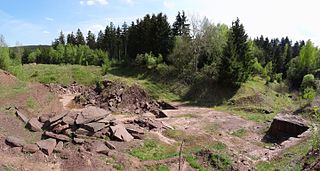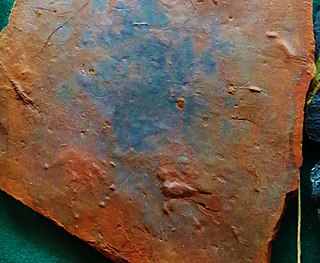Lysorophia is an order of fossorial Carboniferous and Permian tetrapods within the Recumbirostra. Lysorophians resembled small snakes, as their bodies are extremely elongate. There is a single family, the Molgophidae. Currently there are around five genera included within Lysorophia, although many may not be valid.

Diadectidae is an extinct family of early tetrapods that lived in what is now North America and Europe during the Late Carboniferous and Early Permian, and in Asia during the Late Permian. They were the first herbivorous tetrapods, and also the first fully terrestrial animals to attain large sizes. Footprints indicate that diadectids walked with an erect posture. They were the first to exploit plant material in terrestrial food chains, making their appearance an important stage in both vertebrate evolution and the development of terrestrial ecosystems.

A fossil track or ichnite is a fossilized footprint. This is a type of trace fossil. A fossil trackway is a sequence of fossil tracks left by a single organism. Over the years, many ichnites have been found, around the world, giving important clues about the behaviour of the animals that made them. For instance, multiple ichnites of a single species, close together, suggest 'herd' or 'pack' behaviour of that species.
Ichniotherium is an ichnogenus of tetrapod footprints from between the Late Carboniferous period to the Early Permian period attributed to diadectomorph track-makers. These footprints are commonly found in Europe, and have also been identified in North America and Morocco. Three ichnospecies of Ichniotherium have been proposed as valid: I. cotta, I. sphaerodactylum, and I. praesidentis.

Palmichnium is an ichnofossil genus, interpreted as a eurypterid trackway. It has been found by many places around the world, such as Australia, Canada, United States and Wales.

Orobates is an extinct genus of diadectid reptiliomorphs that lived during the Early Permian. Its fossilised remains were found in Germany. A combination of primitive and derived traits distinguish it from all other well-known members of Diadectidae, a family of herbivorous reptiliomorphs. It weighed about 4 kg and appears to have been part of an upland fauna, browsing on high fibre plants.

The Tambach Formation is an Early Permian-age geologic formation in central Germany. It consists of red to brown-colored sedimentary rocks such as conglomerate, sandstone, and mudstone, and is the oldest portion of the Upper Rotliegend within the Thuringian Forest Basin.

The Abo Formation is a geologic formation in New Mexico. It contains fossils characteristic of the Cisuralian epoch of the Permian period.

The Teekloof Formation is a geological formation that forms part of the Beaufort Group, one of the five geological groups that comprises the Karoo Supergroup in South Africa. The Teekloof Formation is the uppermost formation of Adelaide Subgroup deposits West of 24ºE and contains Middle to Late Permian-aged deposits and four biozones of the Beaufort Group. It overlies the Abrahamskraal Formation. The Teekloof Formation does not underlie other units other than the younger Karoo dolerites and sills that relate to the emplacement of the Early Jurassic Drakensberg Group to the east. Outcrops and exposures of the Teekloof Formation range from Sutherland through the mountain escarpments between Fraserburg and Beaufort West. The northernmost localities of the Teekloof Formation are found by Loxton, Victoria West and Richmond.
This article records new taxa of trace fossils of every kind that are scheduled to be described during the year 2019, as well as other significant discoveries and events related to trace fossil paleontology that are scheduled to occur in the year 2019.

Dromopus is a reptilian ichnogenus commonly found in assemblages of ichnofossils dating to the late Pennsylvanian to the late Permian. It has been found throughout Europe, as well as in the United States, Canada, and Morocco. Several ichnospecies have been named; only the type ichnospecies D. lacertoides is definitively recognized.
Gwyneddichnium is an ichnogenus from the Late Triassic of North America and Europe. It represents a form of reptile footprints and trackways, likely produced by small tanystropheids such as Tanytrachelos. Gwyneddichnium includes a single species, Gwyneddichnium major. Two other proposed species, G. elongatum and G. minore, are indistinguishable from G. major apart from their smaller size and minor taphonomic discrepancies. As a result, they are considered junior synonyms of G. major.

Protochirotherium, also known as Protocheirotherium, is a Late Permian?-Early Triassic ichnotaxon consisting of five-fingered (pentadactyl) footprints and whole tracks, discovered in Germany and later Morocco, Poland and possibly also Italy. The type ichnospecies is P. wolfhagenense, discovered by R. Kunz in 1999 alongside Chirotherium tracks, was named and described in 2004 and re-evaluated in 2007; a second ichnospecies, P. hauboldi, also exists, which was initially described as an ichnospecies of Brachychirotherium. Protochirotherium-like prints have also been documented from the Late Permian of Italy, possibly representing the oldest known fossils of mesaxonic archosauromorphs.
Wakinyantanka is an ichnogenus of footprint produced by a large theropod dinosaur from the Late Cretaceous Hell Creek Formation of South Dakota. Wakinyantanka tracks are large with three long, slender toes with occasional impressions of a short hallux and narrow metatarsals. Wakinyantanka was the first dinosaur track to be discovered in the Hell Creek Formation, which remain rare in the preservational conditions of the rocks. The potential trackmakers may be a large oviraptorosaur or a small tyrannosaurid.
Rhynchosauroides is an ichnogenus, a form taxon based on footprints. The organism producing the footprints was likely a lepidosaur and may have been a sphenodont, an ancestor of the modern tuatara. The footprint consists of five digits, of which the fifth is shortened and the first highly shortened.
The Timezgadiouine Formation, sometimes spelled as the Timesgadiouine Formation, is a Triassic geological formation in the Argana Basin of Morocco. It is a succession of red bed sediments spanning from the Olenekian to at least the Carnian, encompassing members T3 to T5 of the Argana Group. It is preceded by the Permian Ikakern Formation and succeeded by the Late Triassic Bigoudine Formation.

Supaia is an extinct genus of fern-like plants, possibly seed ferns. Species belonging to the genus lived during the Permian in North America, east Asia, and Madagascar. The leaves were adapted to minimize water loss, and the genus is thought to have grown as small trees in a mudflat environment subject to frequent drought.

Dimetropus is a reptile ichnogenus commonly found in assemblages of ichnofossils dating to the Permian to Triassic in Europe and North America. Analysis of trackways of Dimetropus provides evidence that the tracks were left by diadectids or non-therapsid synapsids ("pelycosaurs").
Batrachichnus is an amphibian ichnogenus commonly found in assemblages of ichnofossils dating to the Mississippian to Triassic of North America, South America, and Europe. The animal producing the tracks was likely a temnospondyl. B. slamandroides is the smallest known tetrapod footprint, produced by an animal with an estimated body length of just 8 millimeters (0.31 in)

Hyloidichnus is a reptile ichnogenus commonly found in assemblages of ichnofossils dating to the Permian to Triassic in North America, Africa, South America, and Europe.











